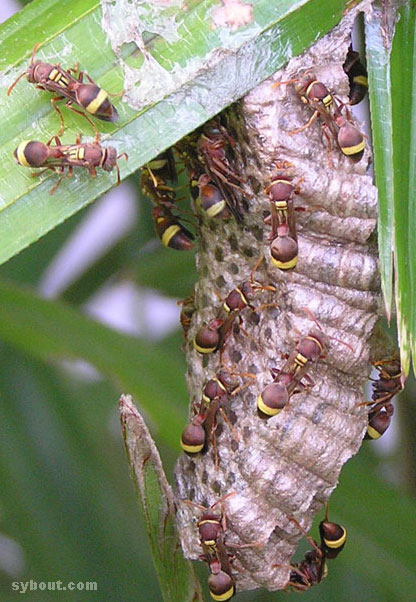Red Cotton Bug
Latin: Dysdercus cingulatus
Family: Pyrrhocoridae
Order: Hemiptera
English: English: Red Cotton Bug, Red Cotton Stainer, Cotton Stainer Bug
Indonesian: (unknown)
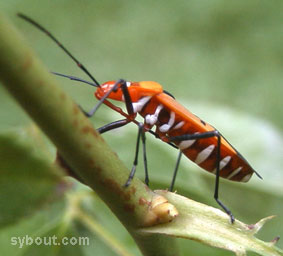
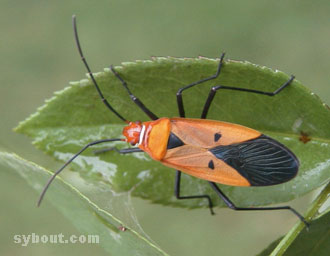
As I know little about insects I had some problems finding the name
of this bug. To make it have a name I have called it Nemo Bug for
years. Now, after searching the internet, I guess it is a Red
Cotton Bug (Dysdercus cingulatus). Whatever its name, I
like the surprising pattern and color combination on its chest. So
far it only once visited my garden. The photo was made while it was
resting on a rose shrub. The Red Cotton Bug feeds on a variety of
plants, not just cotton. Probably this animal could not find
anything interesting in my garden, as it left soon and never
returned.
Asian Papaya Fruit Fly
Latin: Bactrocera papayae
Family: Tephritidae
Order: Diptera
Indonesian: Lalat buah
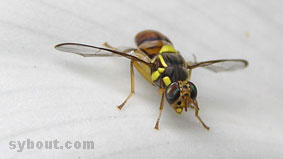
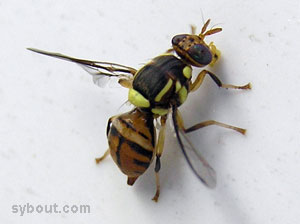
I classified this as a fruit fly (Bactrocera papayae).
Please
correct me if I am wrong.
It is certainly not a very regular guest of the garden. May be I
should be happy for that as it might go for the fruits of our mango
tree.
The Papaya Fruit Fly can do much damage to a wide rage
of fruits and fleshy vegetables including mango, banana, papaya,
guava and tomato. Control is easiest done by fruit bagging,
destruction of fallen and overripe fruits, and the early harvest of
mature green fruits.
Predatory Fly Species
Latin: (unknown)
Family: (unknown)
English: (unknown)
Indonesian: (unknown)


The first photo is one of the few insect pictures where I am
satisfied enough about the quality. The second photo is the same
animal seen from a different angle, but a bit out of focus. There is
still much to learn about photography...
I have been told
that this is a "predatory fly". So, does this mean that it is a
"good guy" who might help to control the fruit flies shown above? I
can not find its name. Who can help me? Like the fruit fly above it
is a rare guest of my garden.
Fly Species
Latin: Lucilia spec.?
Subfamily: Luciliinae?
Family: Calliphoridae?
Order: Diptera
English: Blowfly?
Indonesian: (unknown)
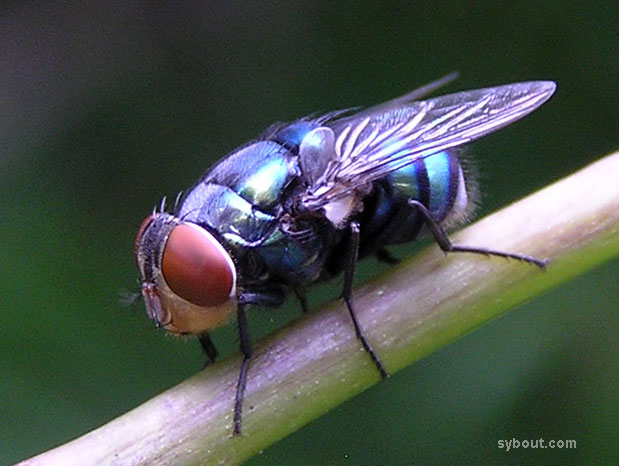
After a searching in
different sources, I realised that this certainly is not the only
fly species with red eyes. The world of flies only has a amazing
variety. Who can help me in the right direction?
Is this a Lucilia spec.?
Lime Butterfly
Latin: Papilio demoleus
Family: Papilionidae
Order: Lepidoptera
English: Lime Butterfly, Lime Swallowtail, Lemon Butterfly
Indonesian: Kupu-Kupu Jeruk
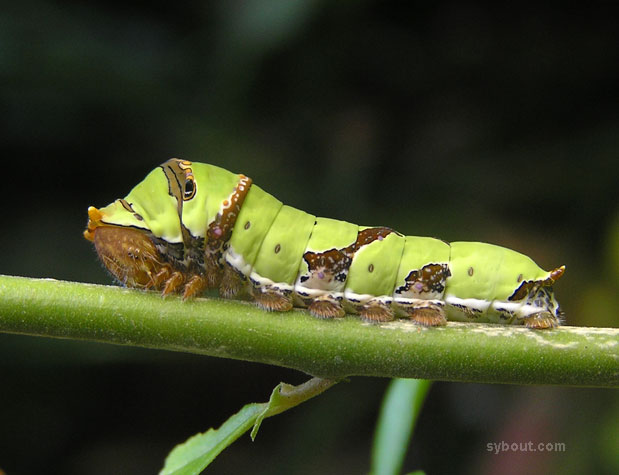
The caterpillar above
probably is the best insect picture I have made so far. Though the
animal was only a few centimeters long, the photo shows much
detail. This was a reason for me to look for more information on the
body parts of caterpillars.
In the picture the caterpillars head is on the left. It has a
brown-yellowish color. The tiny black spots in it are eyes. The
black patch on the back is one of the falls eyes, that probable have
the function of impressing enemies. Somewhere at the head should be
the mouth parts, but I cannot discover any.
Like all insects the
caterpillar has six legs attached to the thorax. Three legs are
visible just right of the head. The other leg-like body parts
attached to the abdomen are prolegs or falls legs. These prolegs have no segments or joints,
but have a circle or band of tiny hooks to grip for support.
The
abdomen exists of ten segments, of which number 9 and 10 are fused. The oval holes at the side of the
abdomen segments are called spiracles and are used for breathing.
I have no idea
what function the little antennae at the end of the caterpillar have.
Like all caterpillars, this animal was continuously eating.
A few days after I made the picture above I found the pupa of the
caterpillar in a plant nearby its former place. It was attached with
its tail and a silky girdle to a leave stalk.
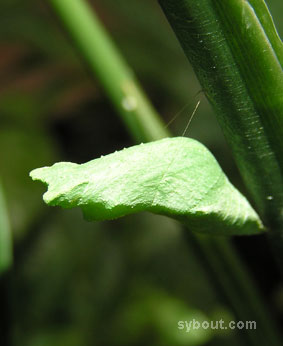
Later I discovered that there often are Lime Butterfly larva on my citrus trees.
When the larva are still young they look like bird droppings. This is a protection system that makes them less attractive for predators. In case there is in spite of that a predator
coming near, the caterpillar shows red coloured glands (osmeterium) from its head. These glands release a pungent smell that seems to drive the predator away. Both young and older larva of the lemon butterfly can display their osmeterium.
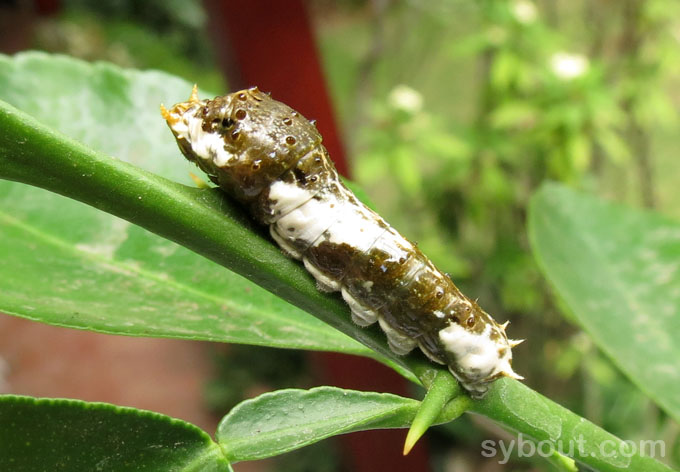
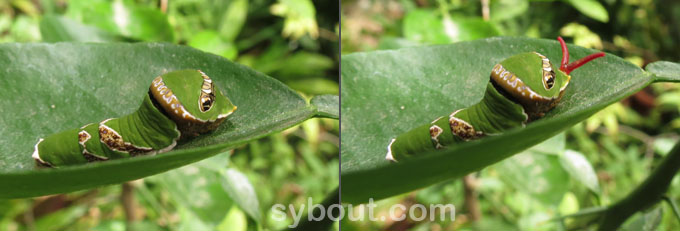
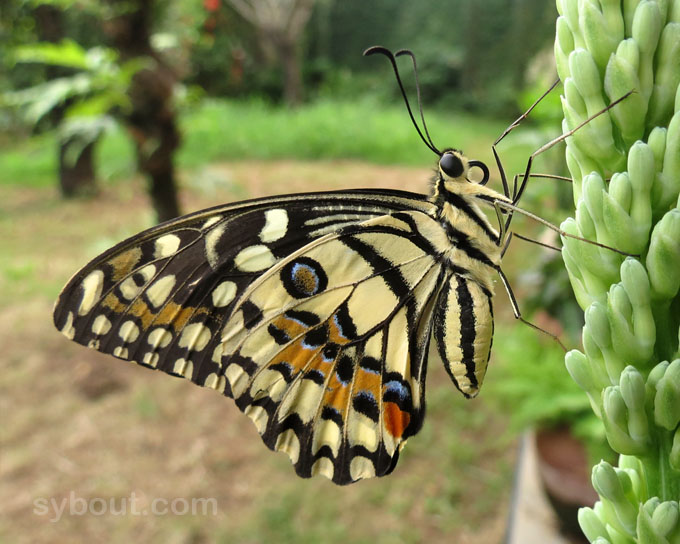
The Lemon Butterfly is said to be common in South East Asia. Both larva and
butterfly are attractive, but as
in some areas the larva are a pest causing much damage in citrus plantations, not everybody will be happy to see them.
There seems to be some subspecies of the butterfly. I still have to find out what their
characteristics are.
Unknown Bug (on Mango)
Latin: (unknown)
Family: (unknown)
Indonesian: (unknown)
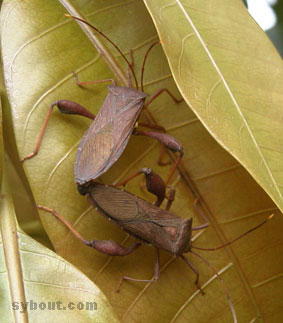
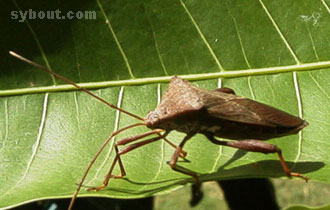
What is the name of these bugs? Please help.
I often find them on the young leaves of the mango tree. It seems they suck sap, after which the leaves wither.
Longhorn Beetle species
Latin: (unknown)
Family: Cerambycidae?
Indonesian: (unknown)
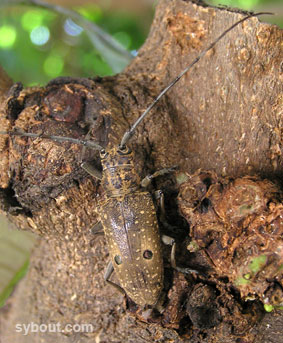
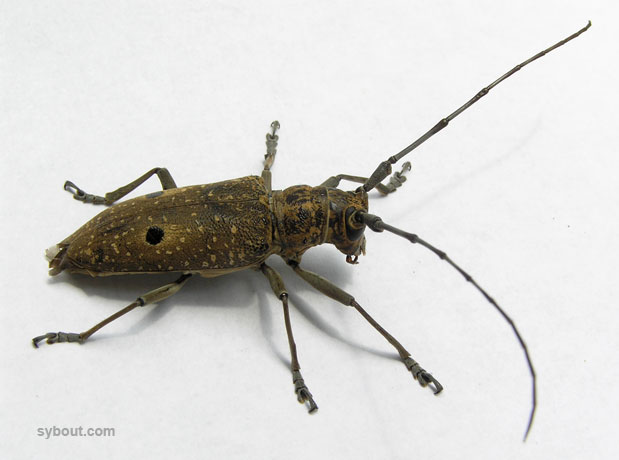
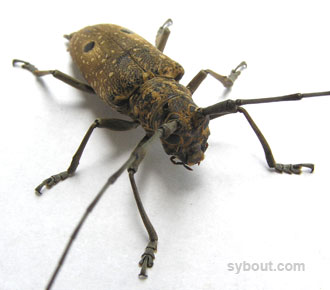
One evening I found the beetle in the pictures above next to the outdoor lamp. Because of the lack of light I could not make a photo showing enough details. The next day I could just in time safe the animal from the claws of our cat who was playing with it in the lawn. After making some shots in a place with enough light I released it in the mango tree where it blended in perfectly with the bark.
The beetle measures
about 3 cm. It has striking long antenna of about 4 cm length. Next
to that the two false eyes on the back are characteristic.
So far I did not find
out what this animal consumes. It was basically inactive.
I am certainly not a
entomologist and haven't seen much close ups of insects yet. That's
why it always is a surprise when I blow up macro shots of these
creatures and look at the details like legs, mouth parts, antenna
and eyes. Do I see well that the eyes of this beetle are positioned
around the bases of the antenna? Strange... .
Little Orang Bug
Latin: (unknown)
Family: (unknown)
English: (unknown)
Indonesian: (unknown)

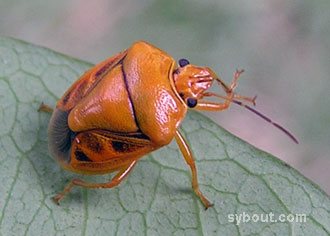
While working in the garden I found a little orange bug sitting on
my arm. As it did not try to fly away, there was enough time
to put it on a leave and photograph it. It is the first time that I
see this animal. After it finally was bored to pose in front of the
camera it went for a flight. I have looked around to find out where
it was hiding and on which plants it lives, but nothing to discover.
Common Bluetail
Latin: Ischnura senegalensis
Family: Coenagrionidae
Engish: Common Bluetail, Marsh Bluetail, African Bluetail, Senegal Golden Dartlet
Indonesian: Capung Jarum

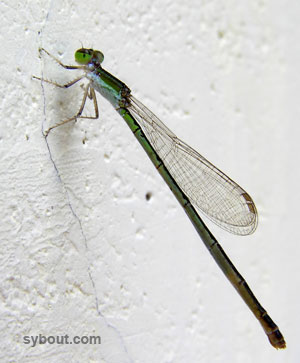
Damselflies rarely visit my garden, but I was ably to make a picture when one was friendly enough to pose for a while on a white painted wall.
The Common Bluetail is native from Africa, through the Middle East, Southern and Eastern Asia up to Papua New Guinea.
Red Dragonfly
Latin: Neurothemis manadensis (N. terminata?)
Family: Libellulidae
Indonesian: Capung Merah

When I tried to identify the dragonfly in the photo above, I learned that there are several red-brown colored species that are common in Indonesia. They look very much the same, but have slightly different wing tips. Based on that I think it is: Neurothemis manadensis
There are times that several dragonflies visit my garden for weeks.
The bigger part of the year I cannot find any though.
I guess there is a "dragon fly season", but I don't know yet during which months this is.
Oriental Migratory Locust
Latin: Locusta migratoria manilensis
Family: Acrididae
Indonesian: Belalang kembara

The Oriental Migratory Locust is common in a big part of South East Asia. Normally it lives solitary, but in certain conditions in can develop into swarms damaging crops.
Sometimes I find a plant invested with young locusts. Normally these disappear before they can finish the plant. I guess they are eaten by predators.
Planthopper species
Latin: Siphanta?
Family: Flatidae
Indonesian: Wereng ..... ?
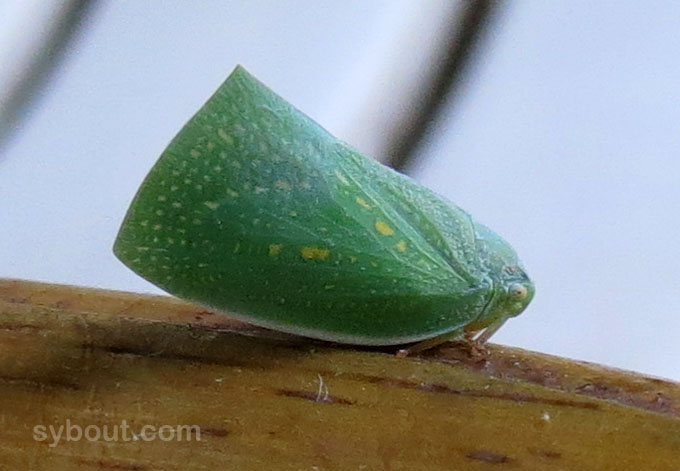
This about 1-cm-size green planthopper was once sitting next to my chair on the terras. I still have to find out its name and what is the cotton-like stuff in between its wings/shields.
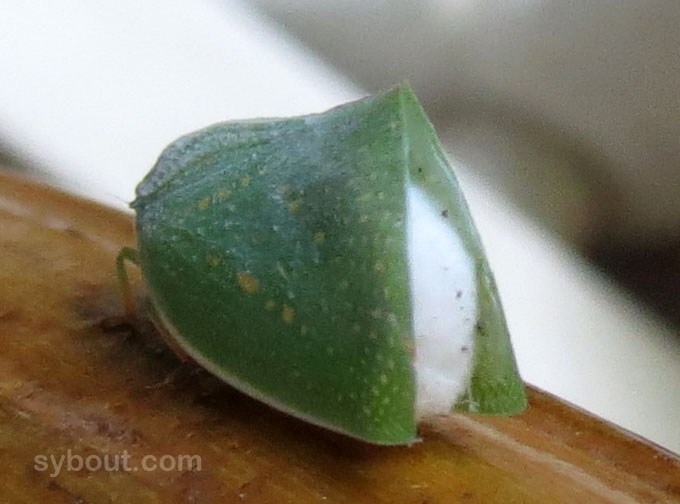
Paper Wasps
Latin: (unknown)
Family: Vespidae
Indonesian: Tawon Kertas
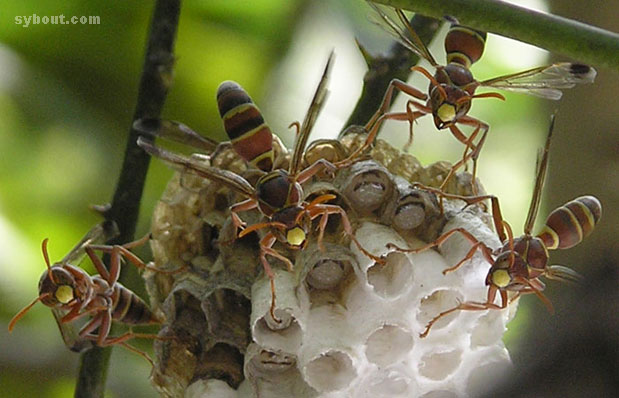
Above and below two different species of paper wasps. The picture above shows the insects on their comb with larvae inside. Again I would be pleased if somebody can tell me the scientific names of these species.
The wasps construct the combs of paper-like material made by chewing and mixing plant and wood fibers with their saliva.
